Explore the magnificent Jagannath Temple in Puri, Odisha. Discover its rich history, stunning architecture, and spiritual significance.
Puri, Odisha, is one of the Char Dham pilgrimage sites. Devotees built this 12th-century temple to honor Lord Jagannath, an incarnation of Vishnu. The site sees millions of devotees and travelers every year.
This temple is not just a shrine—it is a cosmic center where mythology meets mystery, and where the divine walks with the devotee in every Rath Yatra, every offering, every chant of Jai Jagannath!
Mythology Behind Jagannath Temple
The Jagannath Temple of Puri stands at the crossroads of divine mystery and sacred legend. It forms a key node in India’s Char Dham Yatra, alongside Rameswaram, Badrinath, and Dwarka.
The Madala Panji states that King Indradyumna of Malava built the first Jagannath temple. He performed strict penance to achieve his spiritual goal. Pleased with his devotion, Lord Vishnu told him to go to the seashore of Puri, where he would find a floating log. They should make the deity’s image from that log.
When people saw the glowing log floating in the sea, Debarshi Narada advised the king to carve three deities from it and place them in a shrine. King Indradyumna asked Vishwakarma, the divine architect, to build a grand temple for them. Lord Vishnu himself took the form of a carpenter to carve the deities, but on one condition—no one should disturb him until he finished his work.
But after two weeks, King Indradyumna’s queen grew worried. Since no sound was coming from the temple, she thought the carpenter might have died. She asked the king to open the door. When they entered, Lord Vishnu stopped his work, leaving the deities unfinished. The idols had no hands. Then a divine voice instructed King Indradyumna to place the incomplete deities in the temple.
Historical Journey of Jagannath Temple
King Indradyumna of the Malwa region first commissioned the temple, as per puranic sources. He ruled around 3000 BCE, according to temple tradition. But archaeological evidence and temple inscriptions suggest the current structure came much later.
Most scholars agree that King Anantavarman Chodaganga Deva, of the Eastern Ganga dynasty, built the temple we see today. He began construction in the 11th century CE and completed the main sanctum around 1150 CE.
Jagannath as the royal deity
The Ganga rulers didn’t just build a temple—they established Jagannath as the royal deity. They called themselves Rauta Jagannathanka—servants of Jagannath—and ruled in his name. This divine kingship helped them legitimize their rule and unify the region.
In the 13th century, King Narasimhadeva I of the same dynasty built the famous Konark Sun Temple, showing the dynasty’s deep commitment to temple architecture and Vaishnavite devotion. Puri, under their rule, emerged as a powerful religious center.
Muslim invasions
During the Muslim invasions, the temple faced repeated threats. Historians note at least 18 recorded attacks, especially during the rule of Khilji and Mughal generals. The priests and devotees safeguarded the idols by hiding them in remote places like Chilika Lake, Gopali, and Banki. Each time, they brought the deities back and restored the temple’s sanctity.
The Mughal Emperor Akbar, interestingly, granted jagir (land revenue) to the temple. Though a Muslim ruler, he respected its influence. Later, under Aurangzeb, the temple again faced threats. But the devotion of the people kept it alive.
In the 18th century, the Marathas took control of Odisha and helped restore many temple rituals. They established new endowments and reinforced the daily offerings.
British Period
The East India Company took over temple administration in 1803. They treated the temple as a source of revenue and controlled its affairs. Local resistance forced them to return its management to religious authorities by 1863.
The Rath Yatra attracted both colonial curiosity and local pride. British officers like William Hunter documented the event with awe, though often through an orientalist lens. Still, their records help us understand the temple’s significance in the 19th century.
Post-independence
The Jagannath Temple Act of 1955 placed the temple under a managing committee with a Gajapati Maharaja as the chief servitor. The Odisha government supports the temple, but rituals remain in the hands of sevayats (hereditary priests).
What makes Jagannath Temple historically unique?
This isn’t just a religious center. It has acted as a political hub, a cultural anchor, and a symbol of resistance. From ancient kings to modern statesmen, everyone who ruled Odisha had to bow before Jagannath—not just as a deity, but as the true Lord of the Land.
Architectural Marvel
The Jagannath Temple at Puri stands not just as a sacred site but also as an architectural riddle carved in stone. There are many temples across India, but few challenge our understanding of ancient engineering the way this one does.
The temple stands tall at 214 feet. The towering spire (Shikhar) dominates Puri’s skyline. Builders used khondalite stones, a material native to Odisha, which we can still see in the coastal hills nearby. They didn’t use mortar. Instead, massive stones lock perfectly using interlocking systems. Time hasn’t shaken it. Cyclones, salty winds, and centuries of wear have failed to bring it down.
Kalinga style
The layout follows the classical Kalinga style of temple architecture. Four main structures stand in alignment—Vimana (sanctum), Jagamohana (audience hall), Nata Mandira (dance hall), and Bhoga Mandapa (offering hall). Each serves a unique ritual function, designed with remarkable precision.
The temple complex covers over 400,000 square feet, enclosed by two massive walls—Meghanada Prachira and Kurma Bedha. Inside, 120 temples and shrines speak of a layered ritual tradition. Some scholars believe this multi-shrine layout represents a cosmic city.
What truly puzzles experts
Every day, the temple’s flag flutters against the wind. Meteorologists can’t explain it. The priest climbs the spire daily to change it, without safety gear, echoing a 1,000-year-old ritual. This defiance of wind direction remains a mystery.
Another unexplained feature: the temple casts no shadow—at any time of day. Vertical shadow always aligns closely with the base. Some suggest it’s the design of the dome; others think it’s divine geometry.
Massive Metal Wheel
Above the sanctum sits the Neelachakra—a massive metal wheel made of an alloy called Ashtadhatu (eight metals). It weighs over a ton. No one knows exactly how builders hoisted it to that height in the 12th century. Today, it stands firm, surviving storms and corrosion.
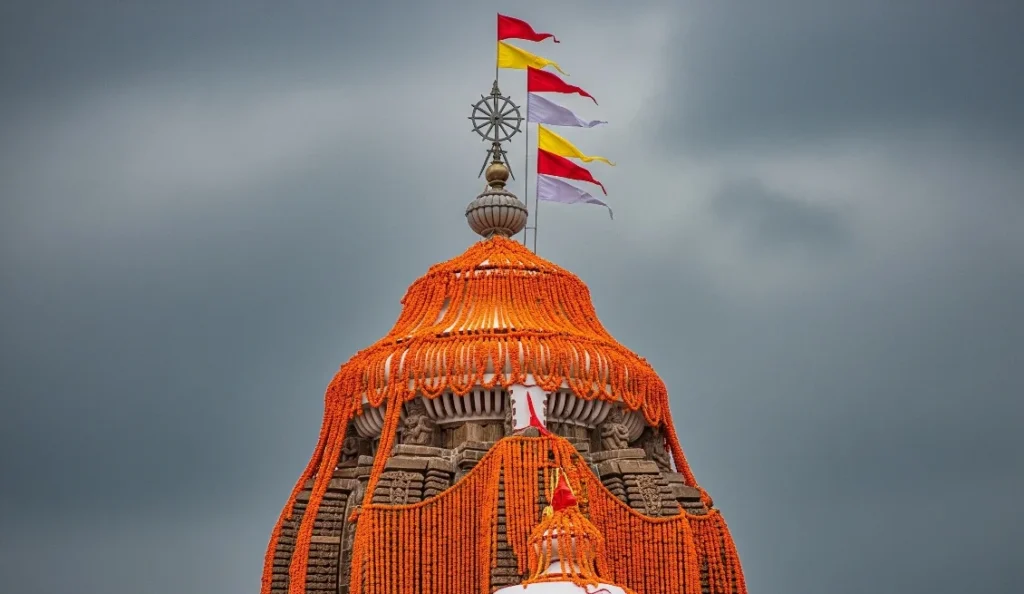
Each stone block weighs several tons. Builders likely transported them from far-off quarries by raft via rivers like Mahanadi and then hauled them using logs and elephants. But how they achieved such precision without iron clamps or cranes? That remains unsolved.
The Grand Kitchen
The temple’s kitchen is the largest open kitchen in the world. Archaeologists and culinary historians alike marvel at its design. Cooks stack pots one atop another on traditional wood-fired stoves. Yet the food in the top pot always cooks first. This reverse thermal flow violates every known principle of heat distribution.
Geographical Location
Puri, also known as Jagannath Puri, is a city on the eastern coast of Odisha in India, on the Bay of Bengal. Puri is a part of Odisha Golden Triangle that includes Bhubaneswar and Konark. This beach town is a spiritual center and a vacation place for beach lovers with its golden sand and calm sea. The Puri name means the holy city. The meaning of ‘Puri’ itself is that this city.
| Location Details | Information |
| State | Odisha, India |
| Distance from Bhubaneswar | 60 km |
| Geographical Feature | Coastal town on Bay of Bengal |
| Nearby Cities | Bhubaneswar, Konark |
How to Reach Jagannath Temple
You can reach the Jagannath Temple in Puri quite easily.
By Air
Nearest Airport: Biju Patnaik International Airport in Bhubaneswar, about 60 km away. Flights connect Bhubaneswar with all the major cities—Delhi, Mumbai, Kolkata etc.
Railway
Nearest Rail station: Puri Junction is only 2.6 km from the temple. Direct trains come in from Delhi, Kolkata, Chennai, Mumbai, all the major cities.
By Road
National and state highways connect Puri well. From Bhubaneswar, it’s about a 65 km drive via NH316, taking around 1.5 hours. Regular buses, cabs, and even shared autos are available for budget travelers.
My Journey from Kolkata to Puri
Having visited Puri many times before, I can say each trip has its own charm — but winter holds a special place in my heart. The pleasant weather, less crowded beaches, and serene atmosphere around the Jagannath Temple make it the perfect time for a peaceful getaway.
Last time, I boarded the Puri Express from Howrah Station — a reliable overnight train that I’ve taken on several occasions. The gentle rhythm of the train set the tone for a relaxing journey. As someone who has made this trip multiple times, the familiarity brought a sense of comfort and nostalgia.
I reached Puri Railway Station early in the morning. The cool sea breeze welcomed me the moment I stepped off the train. I took a short auto ride to my hotel, which is located not far from the Jagannath Temple and the beach — a place I often prefer for its accessibility and peaceful surroundings.
Best Time to Visit Jagannath Temple
The ideal time to visit the Jagannath Temple is between October and February, when temperatures range from 10°C to 25°C, offering pleasant weather for temple visits and beach activities. For a vibrant cultural experience, plan your trip during the Rath Yatra festival in June or July, when massive chariots carry Lord Jagannath, Balabhadra, and Subhadra through Puri’s streets, attracting global devotees.
| Season | Months | Weather | Best For |
| Winter | October–February | Cool, 10°C–25°C | Temple visits, beach activities |
| Summer | April–June | Hot, humid | Avoid unless for Rath Yatra |
| Monsoon (Rath Yatra) | June–July | Warm, rainy | Festival enthusiasts |
Important Note: The Jagannath Temple restricts entry to Hindus only, a rule established due to historical invasions to protect its sanctity. Non-Hindus can admire the temple’s exterior from the Lion Gate (Singhadwara) and experience its cultural vibrancy.
Where to Stay in Puri: From Budget to Luxury
Puri, being one of India’s most visited pilgrimage and beach destinations, offers a wide range of accommodation options for every kind of traveler. Whether you’re a solo pilgrim, a family on vacation, or someone seeking a spiritual retreat, Puri has something for everyone.
For budget-conscious travelers or pilgrims, holiday homes, dharamshalas, and guesthouses near the Jagannath Temple offer basic yet comfortable facilities at very reasonable rates. These are ideal for those who prioritize temple visits and local experiences over luxury.
Mid-range options like Hotel Shree Hari, Hotel Sonar Bangla, and Toshali Sands offer better amenities, beachfront views, and proximity to major attractions, making them popular among families and small groups.
If you’re looking for a more premium experience, Hotel Mayfair Heritage and the iconic Puri Hotel near the Marine Drive stand out. These luxury stays offer sea-facing rooms, in-house restaurants, and exceptional service — perfect for those seeking relaxation with comfort.
My Stay at Deep Resort
On my last trip, I stayed at Deep Resort. Sea Beach Road hosts this spot between Park Beach Resort and Hotel Shakuntala, just a few steps from the Swargadwar Chaitanya Mahaprabhu statue. The location offers the best of both worlds—quiet surroundings and central placement—with easy access to both the Jagannath Temple and the beach.
The rooms are clean, spacious, and well-ventilated, perfect for travelers seeking a peaceful yet accessible stay. Mornings at Deep Resort are especially calming — with the sea breeze gently flowing in.
Cultural Heritage
People in Puri are absolutely crazy about Lord Jagannath. You can feel it in the air, especially during “Rath Yatra” festival. Imagine crowds everywhere, everyone hyped to pull these gigantic, creaky chariots through the streets. It creates a unique atmosphere.
In Swargadwar market you’ll find insanely colorful Odisha handlooms and super intricate Pattachitra paintings.
Rathyatra: A Grand Festival of Devotion
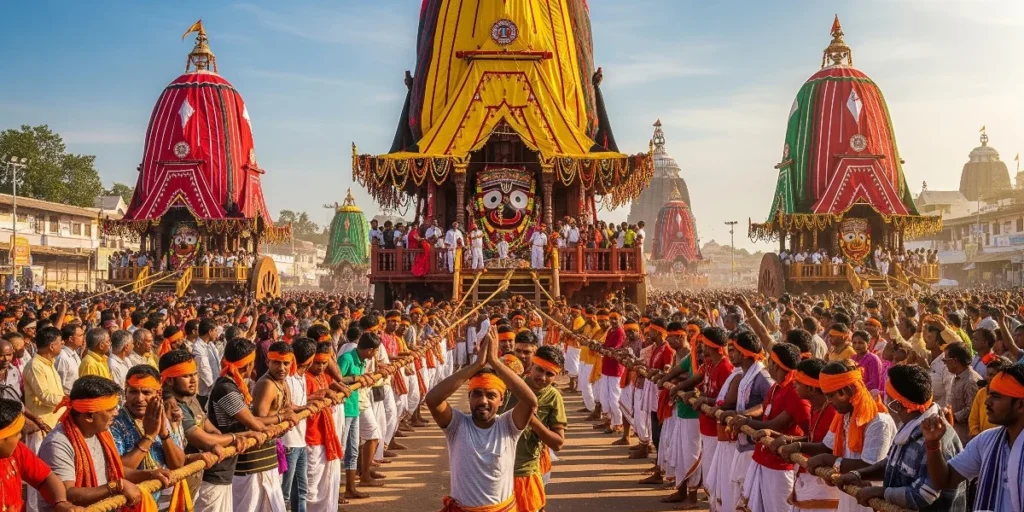
Devotees celebrate the Ratha Yatra of Puri every year during the bright half of Ashadh (June–July), making it the oldest and largest Hindu chariot festival.
During the festival, devotees pull the three deities—Jagannath, his brother Balabhadra, and his sister Subhadra—in massive wooden chariots along the Bada Danda (the grand avenue) to the Gundicha Temple, where the deities stay for a week before returning to the Jagannath Temple.
Devotees call the return journey the Bahuda Yatra. On their way back from the Gundicha Temple, the three deities stop near the Mausi Maa Temple (Aunt’s abode) to receive an offering of Poda Pitha, a special type of pancake believed to be their favorite. After a seven-day stay, the deities return to their original abode.
Honestly, Rathyatra is more than some ancient ritual. It’s a full-blown cultural explosion—devotion & unity. If you ever get a chance, just go experience it. No Instagram post can do it justice.
Ritual of Nabakalebara
Craftsmen do not sculpt the deities of Jagannath, Balabhadra, and Subhadra in stone or metal. They carve them from sacred neem wood—called Daru—that appears only when divine symbols mark it. Devotees consider these idols Swayambhu, or self-manifested. Priests periodically replace them in a secret ritual known as Nabakalebara, held roughly every 12 to 19 years according to precise astronomical calculations.
One lesser-known belief says that Brahma Himself resides in the wooden heart of Jagannath—known as the Brahma Padartha. No one, not even the temple priests, ever sees this core relic. During Nabakalebara, blindfolded and gloved priests transfer it from the old idol to the new one in total darkness, without speaking a word. Tradition says that anyone who sees the relic dies immediately.
Attractions Near Jagannath Temple
Enhance your Puri experience with these nearby attractions:
Golden Beach:

True to its name, the beach is famous for its fine golden sand, azure waters, and magnificent sunrise and sunset views—a favorite spot for photographers and nature lovers. It serves as a sacred space for pilgrims visiting the nearby Jagannath Temple, with the beach forming a tranquil extension to the spiritual city of Puri. Hosts the annual Puri Beach Festival—a cultural celebration featuring sand art displays by Sudarsan Pattnaik and others, eco‑events, and traditional performances.
Konark Sun Temple:
A UNESCO World Heritage Site, 35 km away, renowned for its chariot-shaped design. King Narasingha Deva I of the Eastern Ganga dynasty commissioned the Konark Sun Temple in 1250 CE to commemorate his military victories and devotion to Surya, the Sun God.
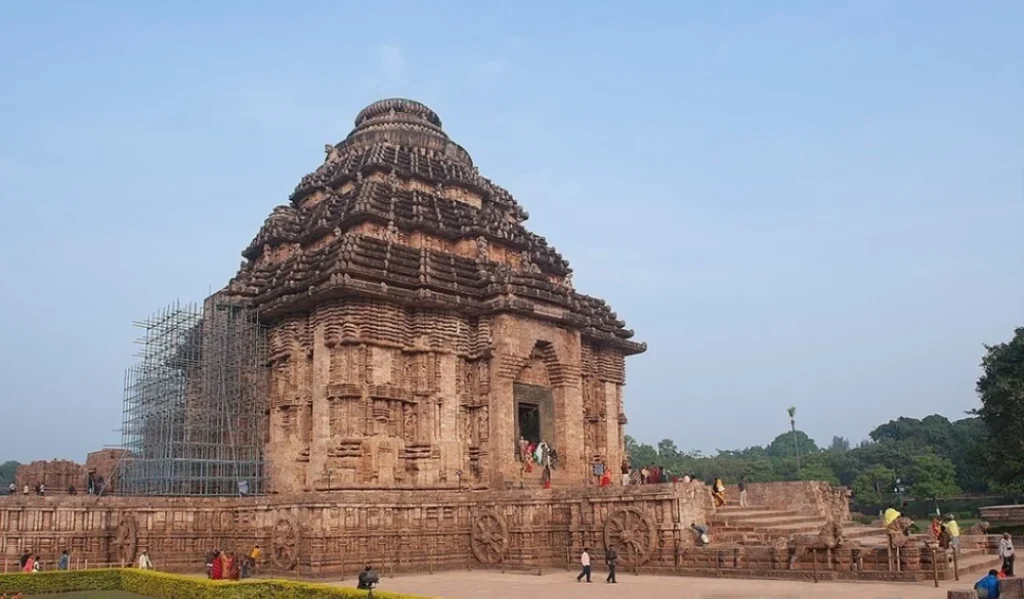
Built over 12 years by around 1,200 artisans under architect Bishu Maharana and aided by his 12-year-old son Dharmapada, who—according to legend—solved the final architectural challenge and sacrificed himself to preserve his father’s honor and the craftsmen’s safety.
Designed to resemble the chariot of Surya, the temple features 12 pairs (24) of intricately carved stone wheels and seven stone horses, representing the twelve months and seven days respectively. Each wheel functions as a sundial, helping to tell time from the shadow of its spokes.
Chilika Lake:
Asia’s largest brackish water lagoon, 50 km from Puri, perfect for birdwatching and boat rides. Chilika Lake, spanning 900–1,165 km² across Puri, Khurda, and Ganjam districts, is the second-largest coastal lagoon in the world and the largest of its kind in India.
A designated Ramsar Wetland of International Importance since 1981, Chilika was once listed on the Montreux Record for ecological degradation, but restoration efforts by the Chilika Development Authority (CDA) led to its removal in 2002.
Raghurajpur Heritage Village:
Raghurajpur, in Puri district, is a UNESCO-recognized heritage crafts village, designated by INTACH in 2000. It was Odisha’s first rural heritage tourism project, developed with an interpretation centre and artisan-led heritage walks.
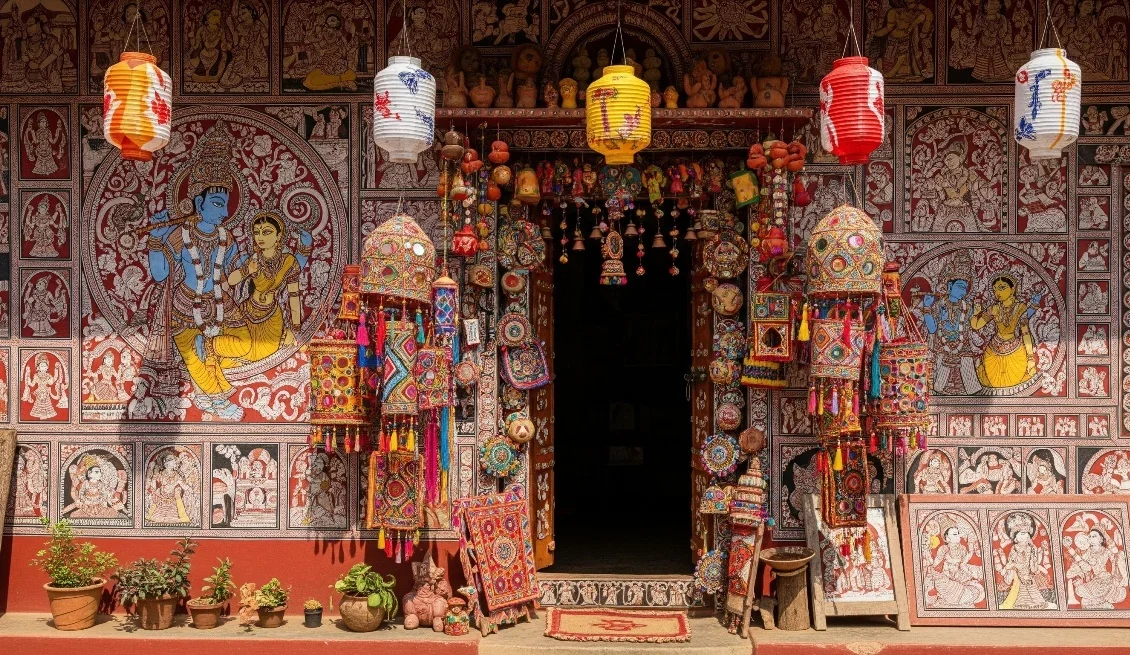
It also won the Best Tourism Village 2023 (Silver Category) for preserving traditions while enhancing livelihoods through tourism. Artisans in the village create Pattachitra—clothed scroll paintings with a 2,500-year history—depicting mythological scenes using natural mineral and vegetable pigments on hand-treated cloth or palm-leaf substrates.
Visitor Tips
- Dress Modestly: Wear traditional or conservative clothing to respect temple customs.
- No Photography: The Jagannath Temple prohibits photography and does not allow cameras inside.
- Savor Mahaprasad: Enjoy this sacred food at the temple’s Ananda Bazaar.
- Plan for Rath Yatra: Book accommodations early if visiting during the festival.
- Respect Restrictions: Non-Hindus should view the temple from outside and honor local traditions.
Conclusion
Visiting the Jagannath Temple in Puri feels like stepping back in time. One moment you are in the busy streets, and the next you stand before an ancient temple that fills you with wonder. During the Rath Yatra, spiritual energy fills the whole city, and every heartbeat seems connected to the Lord. After seeking blessings, you can walk to the nearby beaches for peace and rest. Whether you come for spiritual growth or to see a holy place of great importance, Puri will stay in your heart long after you leave.
May your journey to Puri open doors to ancient wonders and inner peace.
External References
Incredible India –Jagannath Temple
FAQs:
The Jagannath Temple in Puri generally opens around 5:30 AM with the Mangal Aarti and closes by 9:30 PM after the Badasinghara Aarti. Timings may vary on festival days. Darshan is available in different sessions throughout the day.
The cost of VIP darshan at Jagannath Temple in Puri is typically Rs.500 per person. The temple also offers other darshan options like Special Darshan for Rs.50 and Quick Darshan for Rs.100.
The Jagannath Temple in Puri is generally open every day. However, the temple may be closed for specific rituals or festivals for a limited period, such as after Deva Snana Purnima.
In the Jagannath Temple, non-Hindus, foreigners, and those not adhering to the prescribed dress code are generally not allowed entry. Additionally, certain items like footwear, leather products, electronic gadgets, and even some types of food are prohibited within the temple premises.
Mahaprasad is the sacred food offering of Lord Jagannath, cooked in earthen pots over a wood fire in the temple’s Rosaghara (kitchen). It includes rice, dal, vegetables, and sweets, and is distributed in the Ananda Bazaar within the temple.
One of the temple’s mysteries is that its main structure casts no visible shadow at any time of the day—a phenomenon still unexplained by science and architecture experts.
The 22 steps, called Baisi Pahacha, symbolize the 22 stages of life in Hindu philosophy. Devotees often touch or bow at each step before entering the sanctum.
In Jagannath Temple, devotees traditionally avoid stepping on the third step while exiting, known as Yam Shila.


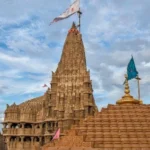

Pingback: Dwarka: Where Myth Meets the Arabian Sea - Temples of India